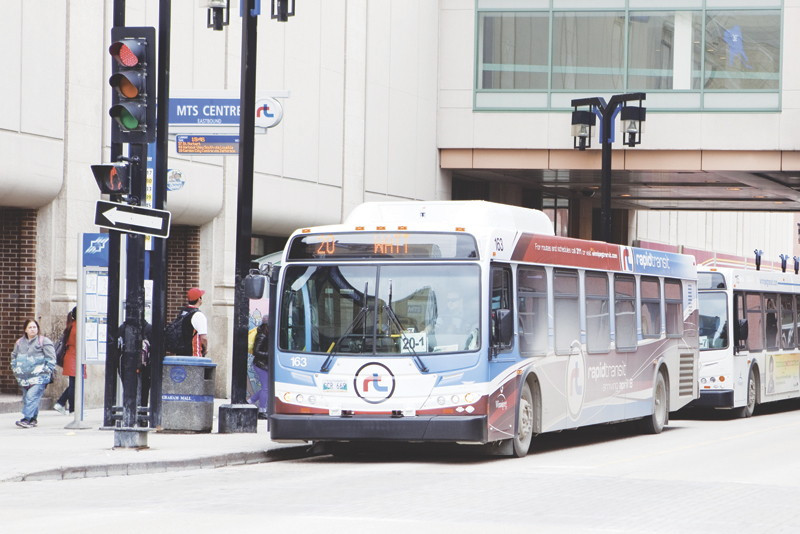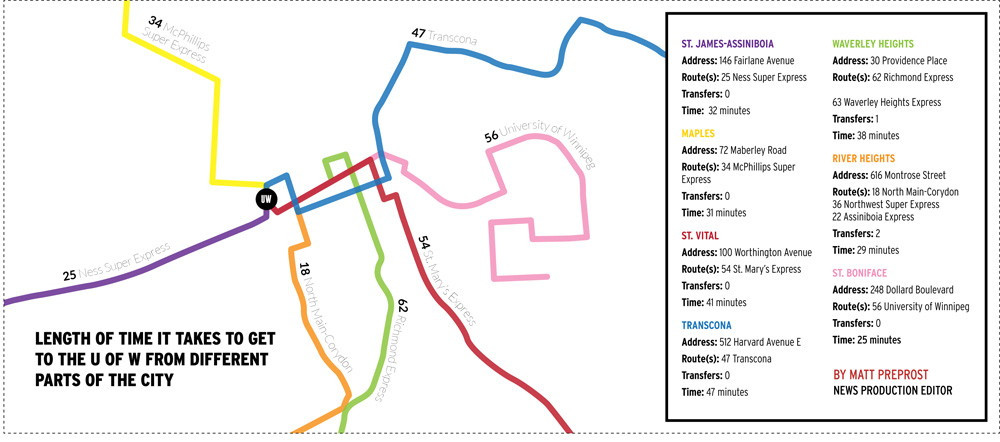The where, when and why of transit
Three steps to a successful public transportation system
With Winnipeg’s first Bus Rapid Transit (BRT) days away from opening to the public, it is clear that our city is moving towards a more efficient form of public transportation.
However, one strip of bus-only expressway is nothing to rest our transit laurels on.
While BRT will surely be a valuable part of Winnipeg’s transit system, certain fundamentals of successful public transportation still remain unaddressed in the city.
According to Alan Hoffman, the founder of the Mission Group, a firm in the U.S. that develops strategies to improve the operation of cities, there are three essential requirements to any successful public transportation system, all of which are focused on the needs of the user.
1. Get people from where they are to where they want to be
This seems like an obvious function of public transit, but in a low-density, sprawling city like Winnipeg, achieving it isn’t necessarily easy.
In order for public transportation to be considered viable, transit hubs need to be situated near places of interest (POI) where users work, live and socialize.
It isn’t cost effective to have buses travel to low-density suburban neighbourhoods with the extent and frequency needed to provide proficient service for residents.
The implementation of hub-and-spoke transit service would aid low-density public transport. This type of system consists of small shuttle buses (the spokes) traveling throughout neighbourhoods to pick up users (possibly
even at their homes) and bring them to central stations (the hubs) on main routes.
The hubs and spokes support each other as higher concentrations of users at central locations mean buses on main routes can run more frequently. The use of GPS and wireless technologies would make this system efficient
and accessible.
Meeting this requirement also entails a conscious and sustained effort by the city to pursue transit-oriented development (TOD).
TOD involves planning for mixed-use, high-density urban areas around transit routes and stations. This development decreases walking time between POIs and transit stations, effectively increasing convenience of using transit while decreasing the need for automobiles.
Construction of Winnipeg’s first TOD is currently underway in Fort Rouge along the new rapid transit corridor.
Implementing TOD on a city-wide scale requires city hall to steer developers away from the conventional suburban form towards infill, mixed-used and high density projects. By creating and improving accessible urban neighbourhoods,demand for urban development will increase, creating positive feedback.
2. Don’t make people wait.
Long wait times and unreliability are deterrents to taking public transit.
Regardless of the type of system (light rail, BRT, regular buses), if vehicles are there when people need them and are going to where they want to go, the system will be used.
Transit planning needs to become more flexible.
Bus schedules must adapt to meet changing transportation needs of our community during non-peak times.
Given the more than 15,000 Jets fans traveling to the MTS Centre for each home game, service to and from the venue should increase, perhaps in the form of charter buses like those for Bomber games.
This is a no-brainer: the building is situated on one of Winnipeg’s busiest transit hubs, Graham Avenue.
Game time traffic is currently overwhelming regular service and the prospect of long wait times provides little incentive for fans to leave their vehicles at home.
Transit service should also be modified to better meet the temporal needs of Winnipeggers who enjoy our city’s bars and clubs.
Winnipeg’s core is home to the busiest drinking establishments in the city, and bus service ends over an hour before last call. If we are serious about curbing drinking and driving and want to expand the use of the transit system, extending transit hours near nightlife hotspots like Osborne Village, Corydon Avenue and the Exchange District is a win-win.
3. Make people feel good about their decision.
Public transit will attract ongoing use by rewarding users for their decision.
The most obvious way to achieve this is by saving them money and/or time. If commuters can travel on public transit as comfortably and conveniently as they would in a vehicle at a fraction of the cost and in the same (or
shorter) amount of time, they will feel good about their choice.
This can only be achieved by meeting the two previous requirements and by avoiding transit fare increases.
There should also be greater incorporation of public transportation and active transportation in the city, such as ensuring that buses with bike racks service certain areas, and that pedestrian and cyclist routes are given adequate attention.
This way, Winnipeggers have even more options when choosing to move without automobiles.
In all, effective transit in Winnipeg is about where, when and why: give people service where they need it, when they need it and have them feeling good about why they’re using it.
Joseph Wasylycia-Leis and Andrée Forest are geography and environmental studies majors at the University of Winnipeg, respectively.
They are currently working to organize a symposium on climate change and sustainability for high school students to be held on campus in May.
Published in Volume 66, Number 26 of The Uniter (April 5, 2012)








